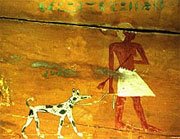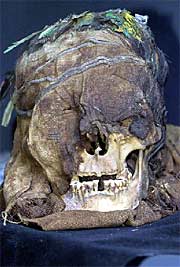The first clothing was symbolic, rather than utilitarian.
A Venus figure carved of bone in 20000 B.C. wears a fringe of twisted fiber strings suspended from a hip band. An array of later clay figures found in the Ukraine, Serbia and Macedonia are likewise clad. Bronze Age women were buried in similar string skirts.
Because they offer neither warmth nor modesty, researchers believe the garments announced a woman's reproductive readiness.
String skirts still exist. Women in northern Albania wear them. In Greece, they are not worn, but passed down from mother to daughter as a talisman of good childbearing fortune.

National Museum of Denmark Wool string skirt from 1300 B.C. was worn wrapped around twice and slung low on the hips. From the peat
Our best knowledge about early Celt textiles comes from the bog people who were preserved in Great Britain and northern European peat.
Peat preserves not only the skeleton, but also the skin, hair, internal organs and – sometimes – the clothing. The Netherlands grave of Emmer-Erfscheidenveen Man, dated to 1310 B.C., included woolen underwear decorated with embroidery, sheepskin cap, calfskin
cape and deerskin shoes.
Huldremose Woman was accompanied by two skin capes, a woolen skirt, scarf and hair band. A large woolen garment, or peplos, was later discovered near the grave. Leg wrappings from another bog body were made of wool, originally dyed blue with woad – a scarce and valuable commodity.
Tollund Man, buried in a pieced leather cap worn fur-side in, was found in a Danish bog in 1950. He is dated to 50 B.C.
In Egypt
When wool and silk became widely available around 4000 B.C., the use of color exploded because animal fibers accept dye so much better than flax.
Only in Egypt, where wool was never much used, did clothing remain white and simple. All Egyptians, regardless of class, wore linen. Differences in status were shown by the fineness of the cloth, which, for royalty, could be almost transparent.
Egyptian men wore knee-length kilts that were often pleated. Women wore slim, tubular shoulder-strap jumpers reaching either above or below the breasts to the ankles. For decoration and color, women wore skirts and even entire dresses of beaded nets, put on over the linen jumpers.
Egyptian weavers also made linens for towels, bedsheets, blankets and mummy wrappings, and to barter. Some are as long as 75 feet long and 9 feet wide. At a hundred threads an inch, that's more than 153 miles of yarn.
Egyptian men favored short, pleated kilts, made of linen.
Ancient Peru
Textiles were valued more than silver by the ancient Andeans. To weave their intricate patterns required extraordinary skill and patience: a single tunic might take nine miles of colored thread.
Textiles uncovered on mummies dating to 500 B.C. on the Paracas Peninsula of Peru are some of the most astonishing ever made. Woven on huge looms, they are vividly colored and often depict strange animals. These textiles were grave goods, meant to accompany the dead to the next life. One mummy, of 429 discovered there, was buried with 56 items of clothing, including 13 turbans.
Incan mummies were bundled in cloth and buried with tools for making textiles.




No comments:
Post a Comment